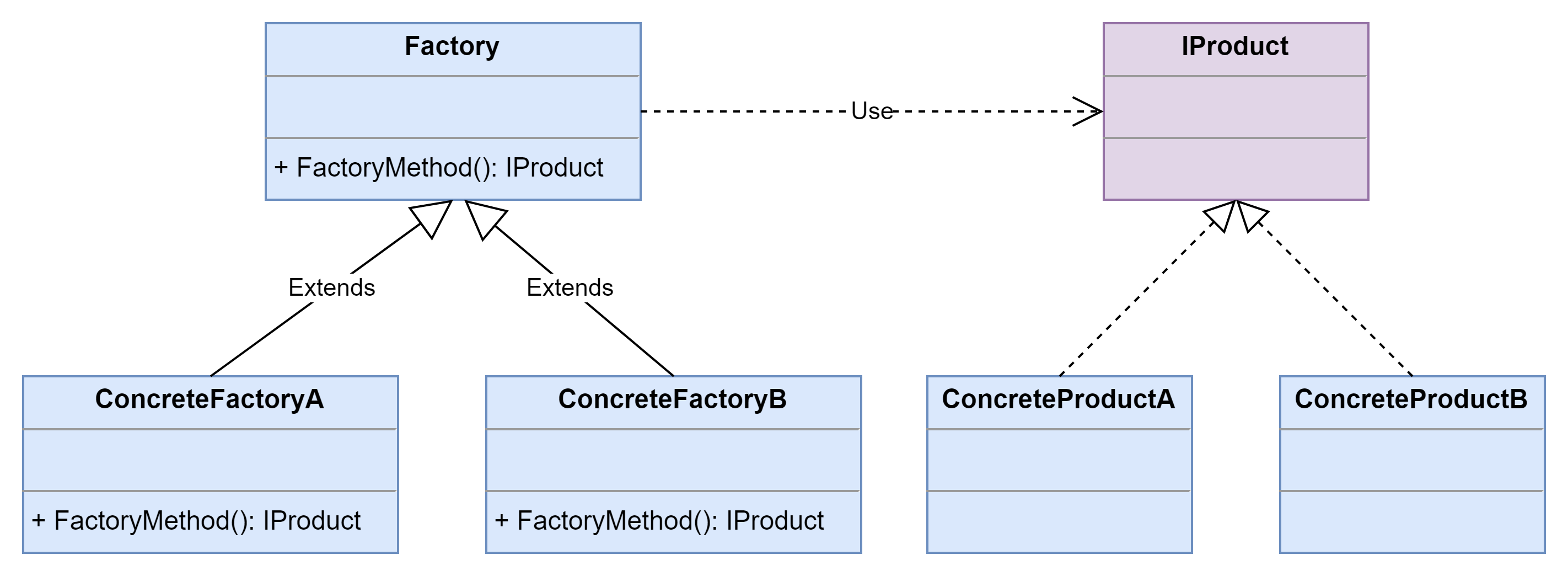工厂方法模式 (Factory Method Pattern)
定义一个用于创建对象的接口,让子类决定将哪一个类实例化。工厂方法模式让一个类的实例化延迟到其子类。
结构图
- Product(抽象产品):它是定义产品的接口,是工厂方法模式所创建对象的超类型,也就是产品对象的公共父类。
- ConcreteProduct(具体产品):它实现了抽象产品接口,某种类型的具体产品由专门的具体工厂创建,具体工厂和具体产品之间一一对应。
- Factory(抽象工厂):在抽象工厂类中,声明了工厂方法(Factory Method),用于返回一个产品。抽象工厂是工厂方法模式的核心,所有创建对象的工厂类都必须实现该接口。
- ConcreteFactory(具体工厂):它是抽象工厂类的子类,实现了抽象工厂中定义的工厂方法,并可由客户端调用,返回一个具体产品类的实例。
示例
using System;
namespace DesignPatterns.FactoryMethod
{
// The Creator class declares the factory method that is supposed to return
// an object of a Product class. The Creator's subclasses usually provide
// the implementation of this method.
abstract class Creator
{
// Note that the Creator may also provide some default implementation of
// the factory method.
public abstract IProduct FactoryMethod();
// Also note that, despite its name, the Creator's primary
// responsibility is not creating products. Usually, it contains some
// core business logic that relies on Product objects, returned by the
// factory method. Subclasses can indirectly change that business logic
// by overriding the factory method and returning a different type of
// product from it.
public string SomeOperation()
{
// Call the factory method to create a Product object.
var product = FactoryMethod();
// Now, use the product.
var result = "Creator: The same creator's code has just worked with "
+ product.Operation();
return result;
}
}
// Concrete Creators override the factory method in order to change the
// resulting product's type.
class ConcreteCreator1 : Creator
{
// Note that the signature of the method still uses the abstract product
// type, even though the concrete product is actually returned from the
// method. This way the Creator can stay independent of concrete product
// classes.
public override IProduct FactoryMethod()
{
return new ConcreteProduct1();
}
}
class ConcreteCreator2 : Creator
{
public override IProduct FactoryMethod()
{
return new ConcreteProduct2();
}
}
// The Product interface declares the operations that all concrete products
// must implement.
public interface IProduct
{
string Operation();
}
// Concrete Products provide various implementations of the Product
// interface.
class ConcreteProduct1 : IProduct
{
public string Operation()
{
return "{Result of ConcreteProduct1}";
}
}
class ConcreteProduct2 : IProduct
{
public string Operation()
{
return "{Result of ConcreteProduct2}";
}
}
class Client
{
public void Main()
{
Console.WriteLine("App: Launched with the ConcreteCreator1.");
ClientCode(new ConcreteCreator1());
Console.WriteLine("");
Console.WriteLine("App: Launched with the ConcreteCreator2.");
ClientCode(new ConcreteCreator2());
}
// The client code works with an instance of a concrete creator, albeit
// through its base interface. As long as the client keeps working with
// the creator via the base interface, you can pass it any creator's
// subclass.
public void ClientCode(Creator creator)
{
// ...
Console.WriteLine("Client: I'm not aware of the creator's class," +
"but it still works.\n" + creator.SomeOperation());
// ...
}
}
class Program
{
static void Main(string[] args)
{
new Client().Main();
}
}
}运行结果
1
2
3
4
5
6
7
App: Launched with the ConcreteCreator1.
Client: I'm not aware of the creator's class, but it still works.
Creator: The same creator's code has just worked with {Result of ConcreteProduct1}
App: Launched with the ConcreteCreator2.
Client: I'm not aware of the creator's class, but it still works.
Creator: The same creator's code has just worked with {Result of ConcreteProduct2}
总结
工厂方法模式是简单工厂模式的延伸,它继承了简单工厂模式的优点,同时还弥补了简单工厂模式的不足。工厂方法模式是使用频率最高的设计模式之一,是很多开源框架和API类库的核心模式。
优点
- 在工厂方法模式中,工厂方法用来创建客户所需要的产品,同时还向客户隐藏了哪种具体产品类将被实例化这一细节,用户只需要关心所需产品对应的工厂,无须关心创建细节,甚至无须知道具体产品类的类名。
- 基于工厂角色和产品角色的多态性设计是工厂方法模式的关键。它能够让工厂可以自主确定创建何种产品对象,而如何创建这个对象的细节则完全封装在具体工厂内部。工厂方法模式之所以又被称为多态工厂模式,就正是因为所有的具体工厂类都具有同一抽象父类。
- 使用工厂方法模式的另一个优点是在系统中加入新产品时,无须修改抽象工厂和抽象产品提供的接口,无须修改客户端,也无须修改其他的具体工厂和具体产品,而只要添加一个具体工厂和具体产品就可以了,这样,系统的可扩展性也就变得非常好,完全符合“开闭原则”。
缺点
- 在添加新产品时,需要编写新的具体产品类,而且还要提供与之对应的具体工厂类,系统中类的个数将成对增加,在一定程度上增加了系统的复杂度,有更多的类需要编译和运行,会给系统带来一些额外的开销。
- 由于考虑到系统的可扩展性,需要引入抽象层,在客户端代码中均使用抽象层进行定义,增加了系统的抽象性和理解难度,且在实现时可能需要用到DOM、反射等技术,增加了系统的实现难度。
适用场景
- 客户端不知道它所需要的对象的类。在工厂方法模式中,客户端不需要知道具体产品类的类名,只需要知道所对应的工厂即可,具体的产品对象由具体工厂类创建,可将具体工厂类的类名存储在配置文件或数据库中。
- 抽象工厂类通过其子类来指定创建哪个对象。在工厂方法模式中,对于抽象工厂类只需要提供一个创建产品的接口,而由其子类来确定具体要创建的对象,利用面向对象的多态性和里氏代换原则,在程序运行时,子类对象将覆盖父类对象,从而使得系统更容易扩展。
This post is licensed under CC BY 4.0 by the author.
